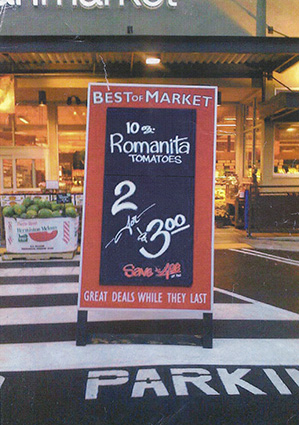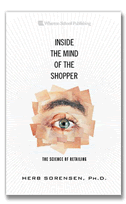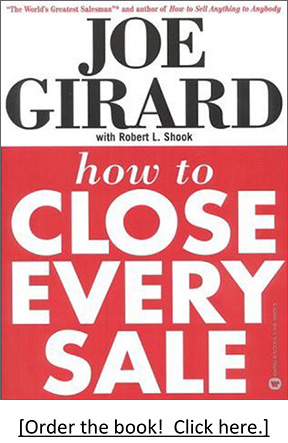What does selling mean?
Whenever a customer acquires something, with a commitment to pay for it, a sale occurs. In every case, this is a culmination of a series of external stimuli for the customer, with a parallel interior mental path for the customer. In general, we can divide all the sales in the world into two classes:
- Sales-person mediated sales, where there are two people involved, the customer and the sales person, with one acquiring and the other guiding and expediting the purchase — selling the customer!
- Self-service sales, where another person is not directly and immediately involved in the purchasing process, the person "selling" is not there, having simply teed up the ball for the shopper to sell themselves.
Self-service retail essentially revolutionized the world of commerce 100 years ago, when selling in stores largely migrated from the first class of selling, to the second class of selling. Notice that in the first class of sale there is often a one-to-one relation with one salesperson addressing one customer at a time, guiding them to the sale/purchase. This can be properly designated as active selling. In the second class, where the "seller" is not actually present, we have, typically, passive selling. I discussed these matters in some detail in Selling vs. Order-taking, which could provide further helpful background to this present discussion.
In this issue of the Views we will select from the teachings of Joe Girard, who has been identified by The Guinness Book of World Records as "The World's Greatest Salesman." This continues my decade long quest to bring the very best of active selling into the passive selling, self-service environment, that dominates a huge share of the $14 trillion dollar annual retail business.
You might also review the earlier Views, The Amazonian Ghost, to get a better understanding of the selling mindset required for active retailing. I also recommend my commentary on the super-selling techniques of Ron Popeil. In many ways, the thinking of people like Joe Girard and Ron Popeil are right at the cutting edge of real selling in the self-service world. And the key to outsize increases in sales and profits!
From Chapter 1:
The Prospect's [Customer's] Time is Valuable
"Every sales person has had it drilled into his or her skull that time is money and should be valued accordingly. So I won't give you another lecture on time management. Instead, I'll emphasize instead the importance of also realizing the value of your prospect's [customer's] time."
Joe Girard's perspective here is exactly the same as my own principle that, "The faster you sell, the more you will sell!" No real sales person would ever be confused about this issue, and yet it is diametrically opposed to standard retailer desire to get the shopper to spend more time in their stores. As one senior shopper "expert" with one of the major brands told me, "We want the shopper to spend time carefully considering our merchandise." Both the retailer's view, and the supplier's, have the air of thoughtful consideration of the shopper and the sales process, but both are actually sales termites. They steadily erode the performance of the store and brand by impeding rapid selections of merchandise.
The fact is that every second longer that it takes for a supermarket to sell one dollar's worth of merchandise, costs the store a million dollars in annual sales. (See Shopper Efficiency vs. Total Store Sales.)
Most Sales People Are Negative
"How in the world can anyone look at somebody and determine if he's going to buy? I've been in the sales field for many years and still have no idea what a buyer is supposed to look like..."
This is a direct challenge to formal segmentation methods that presume to assist in identifying a "target demographic." I have often quoted the retail executive who said to me, "Our target demographic is the stock-up shopper." This was said, even though half of all the shoppers in his stores are buying five or fewer items. Clearly, management of this chain was negative about the large number of quick-trippers in their stores. These quick-trippers are actually "stock-up" shoppers, they just aren't on a stock-up trip. Shoppers change their segmentation identity, sometimes multiple times in a single trip!
Sometimes I think I have seen more brand supplier shopper segmentation schemes than the law allows. All attempting to identify "their shoppers." And I've had any number of clients, in the research environment, confidently assert that the particular shoppers we have in front of us "are not our customers" — especially if one of them has rendered an opinion inimical to the brand narrative.
One of the most insightful observations I have ever heard was from Sandy Swan, then at Dr. Pepper/7 Up, when he said, "I don't care whether the shopper is a sixty year old businessman driving up in a late model BMW, or an eighteen year old coed arriving in a beat-up VW, all I care is if they buy my product!" A great deal of segmentation is misguided, because shoppers move from segment to segment with disturbing regularity. (See Byron Sharp's How Brands Grow., particularly chapter 11, "Why Loyalty Programs Don't Work.")
From Chapter 2:
The Invisible Sign, "Make Me Feel Important!"
"I think it's a matter of showing people that you are sincerely interested in them."
Here we need to return to the device of The Amazonian Ghost, where we have to project ourselves into the aisle, with the shopper, even though we cannot be there with them personally, while they are making their selections. The question is, how can we make a shopper walking past a display know that we "are sincerely interested in them?"
We're on new terrain here, but I will make some suggestions. For example, in the wine department, perhaps don't simply point out, "Your discriminating palate will join the connoisseurs who enjoy this selection," but nearby give a budget, near equivalent, with the notice, "The connoisseur with the sharp pencil enjoys this selection." Now, I would ordinarily not recommend such wordy communications with shoppers who are parsimonious with their time. But a good marketer who understands the sentiment given here and is skilled in conveying words with symbols, pictures, color and the like, should have a superior way of saying to the shopper, "We're sincerely interested in you."
Bear in mind that in the entire wine department, only one or a few matched promotional suites along this line might further express that the retailer and/or brand is "sincerely interested in you," the shopper. Of course such things as quick chillers and other amenities can say this to the shopper as well. The point here is to "personalize" the spirit of your communication with the shopper. And to look at ALL your shopper communications and ask yourself, "Does this say to the shopper, I'm sincerely interested in you?"
From Chapter 3:
Assuming the Sale
"When you continually assume the sale... You're relaying a signal to the prospect's [shopper's] subconscious that he or she will buy your product. His or her subconscious mind is picking up the message 'Buy, buy.'"
Since the package is your in-store "salesman," make sure that all six sides of the box have at least a subtle sale assumption message. One of the most powerful of these is what I call "social marketing" — giving a message about a group that the shopper is affiliated with, or would like to be, at least. "#1 Choice of Choosy Moms," is an example for Jif Peanut Butter. "Connoisseurs choice" is suggested in the wine example above. Rather than words, photos placing the product in the consumption or usage scene of the social — or family — group, would be more effective. This is also one of the powerful motivators mentioned in Robert Cialdini's book, Influence: The Psychology of Persuasion, which I recommend.
In a sense, a picture of a celebrity endorser or cartoon character is also an assumptive seller, since the assumption is that if this endorser or character is associated with this product, the shopper wants to be associated with the endorser-character-product.
From Chapter 4:
Being a Good Listener
"It's too bad they don't teach us more about listening in school."
Indeed, in the store it is a case of the shopper shouting at the top of their lungs by their behavior. "Actions speak louder than words." Personally, I don't have a reputation for being a good listener. But when it comes to shoppers, I am a detailed and meticulous "listener," that is, observer and measurer of just exactly what shoppers do. Where they go in the store, how long they spend doing anything, exactly what they buy, their reaction to all the media and non-media in the store, etc., etc.
That's how I learned the critical importance of the dominant path through the store, and of the top sellers that the shoppers keep shouting about (by buying them.) (See Tell 'em Where to Go; Tell 'em Which to Buy!) It's all about listening to the shoppers.
From Chapter 8:
Choices of Three
"Over the years, I have discovered that the more choices presented to prospects [shoppers,] the more difficult it becomes for them to make up their minds. While I don't have concrete evidence backed by formal research, I have observed that when people have to choose from more than three choices, they have a hard time determining which to pick... I recommend offering a maximum of three."
This principle reinforces what we say about focusing on the top sellers. You can only use Joe Girard's selling principles selectively in the store, if you expect them to be effective. If you use them widely, you are trying to "sell more than three," and your efforts, no matter how good they are, will be diluted severely, and simply become more "noise" in the shopping environment. Fortunately, you can be pretty sure that your competition is churning out a lot of noise. This is your opportunity to provide selective selling to just a few items (a few dozen for a 40,000 item store, but a literal few, 3, for a few dozen items in a brand — or category.)
Go ahead, try targeted selling of your few best selling items, those that shoppers are telling you they most want to buy, because that is what they already buy MOST of!
By the way, the formal research that Joe didn't have can be found in abundance in Sheena Iyengar's book, The Art of Choosing.
From Chapter 9:
Creating a Sense of Urgency The Limited Offer
"Department stores and supermarkets use it to peddle everything from mattresses to frozen orange juice... Failure to buy within a certain timeframe means that you lose the opportunity to get a good deal. Limited offers work, and this explains why the American public is constantly bombarded with such inducements."
This is sometimes called the "take it away" strategy. It is true that most people are more motivated to keep what they have than to acquire something they don't have. With a take-it-away offer, you are essentially giving an opportunity to the shopper, something they can make use of right now, versus losing what they have, the opportunity, by delaying till later.

Notice: Great Deals While They Last. In other words, buy it now or you may lose the opportunity. Costco deploys this strategy every time they bring in a special shipment at a terrific price. You wanted one of those canoes? Sorry, maybe again next year!
From Chapter 11:
The Law of Diminishing Returns
"The greater the lapse of time, the less chance you have of closing the sale."
The longer you take to close the sale, the greater the chance that you are never going to close the sale. If the shopper has been in the aisle a full minute and has not yet put a product in the basket, the odds are great that she isn't going to. On the other hand, if she puts one in within the first 10 seconds, the odds of a second going into the basket, skyrocket.
So we have reviewed 8 great principles that the world's greatest salesman relied on to achieve that distinction. If you try to implement some of these principles as slick strategies... Rather, your own super sales capabilities will come from a change between your ears and in your heart. It is a burning desire to become a self-service "Joe Girard," learning from the best in order to be YOUR best!
Here's to GREAT "Shopping!"
Your friend, Herb Sorensen




